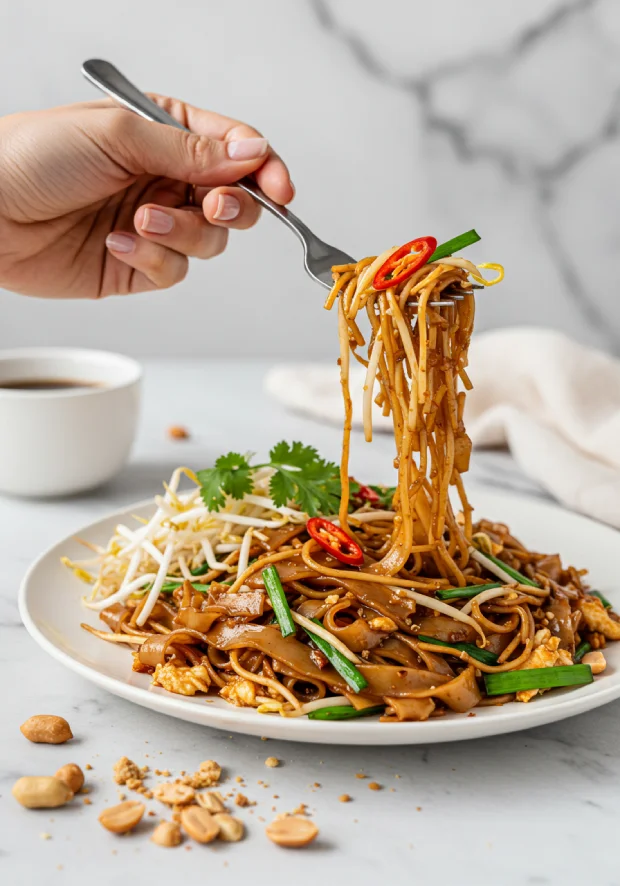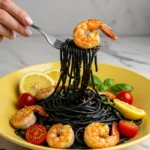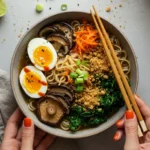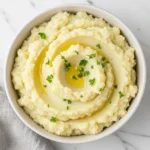By Nadia Else
Culinary Expert & Food Photographer
Picture this: It’s 6:30 PM, your kids are hangry, your partner’s texting, “What’s for dinner?”, and your pantry’s giving you side-eye. Sound familiar? That’s where Kway Teow swoops in like a capeless superhero. I’m Nadia Else, a food photographer and recipe developer who’s spent a decade turning kitchen chaos into crave-worthy meals. Today, I’m sharing my 15-minute Kway Teow hack that’s faster than DoorDash and tastes like a Malaysian street vendor’s best work. No PhD in wok-tossing required.
Table of Contents
What Is Kway Teow?
Kway Teow (pronounced kway-tee-oh) is the rockstar of Southeast Asian street food. Born in the bustling markets of Penang and Singapore, this stir-fried flat rice noodle dish is all about bold contrasts: chewy noodles, smoky “wok hei” (that magical charred aroma), spicy chilies, and sweet-savory sauce. Fun fact: The name comes from the Hokkien words for “flat rice noodles” (kway = rice cake, teow = flat strips). Traditionally cooked over volcanic-level heat, we’re adapting it for home kitchens without sacrificing that street-food soul.
Why This Recipe Works for Real Life
15-Minute Miracle: Faster than boiling pasta.
Pantry MVP: Swap proteins/veggies with freezer staples.
Heat Control: Dial spice up/down for picky eaters.
One-Wok Wonder: Minimal cleanup = more Netflix time.
But here’s the real win: This recipe skips the fussy prep. No hunting for 20 exotic spices—just smart shortcuts (like pre-made chili paste) that keep flavors authentic.
How to Make Kway Teow
Key Ingredients & Smart Swaps
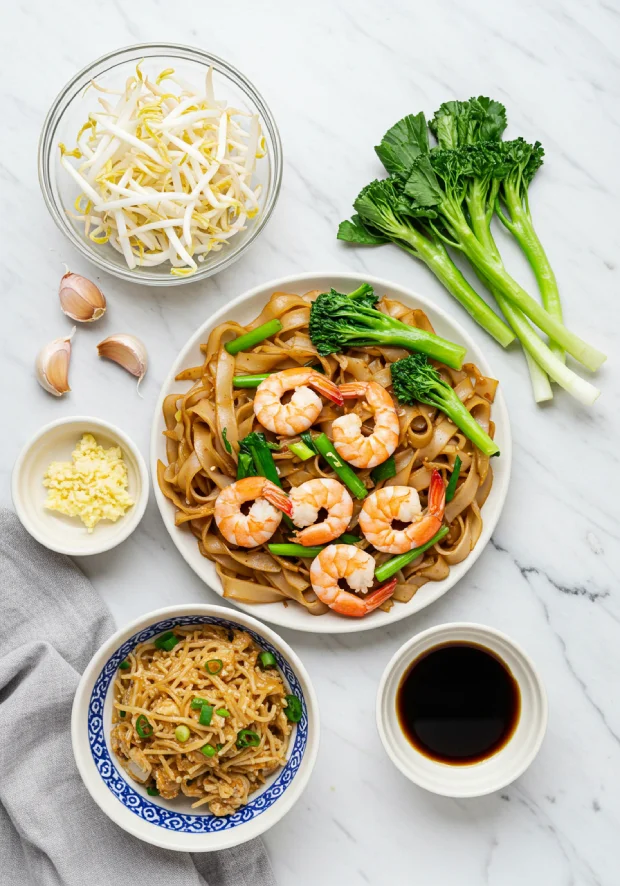

(Serves 4 hungry humans)
Chili Paste (the flavor engine):
- 1 oz dried red chilies (soaked) → Too spicy? Use 1 tbsp smoked paprika + 1 tsp cayenne.
- 2 fresh red chilies → Swap with bell peppers for zero heat.
- 3 shallots → Red onion works in a pinch.
The Sauce (where magic happens):
- 5 tbsp soy sauce → Tamari for gluten-free.
- 1.5 tbsp dark soy sauce → Coconut aminos add sweetness.
- 1 tbsp sugar → Honey or maple syrup for unrefined options.
- ½ tsp fish sauce → Mushroom broth for vegan umami.
Stir-Fry Stars:
- 1 lb fresh flat rice noodles → Look for “pad see ew” noodles.
- 12 prawns → Chicken thighs, tofu, or extra mushrooms.
- Blood cockles → Clams, mussels, or omit for budget-friendly.
- Chinese sausage → chorizo or smoked tempeh.
Pro Tip: Fresh noodles clump? Toss with 1 tsp oil before cooking.
Step-by-Step Instructions
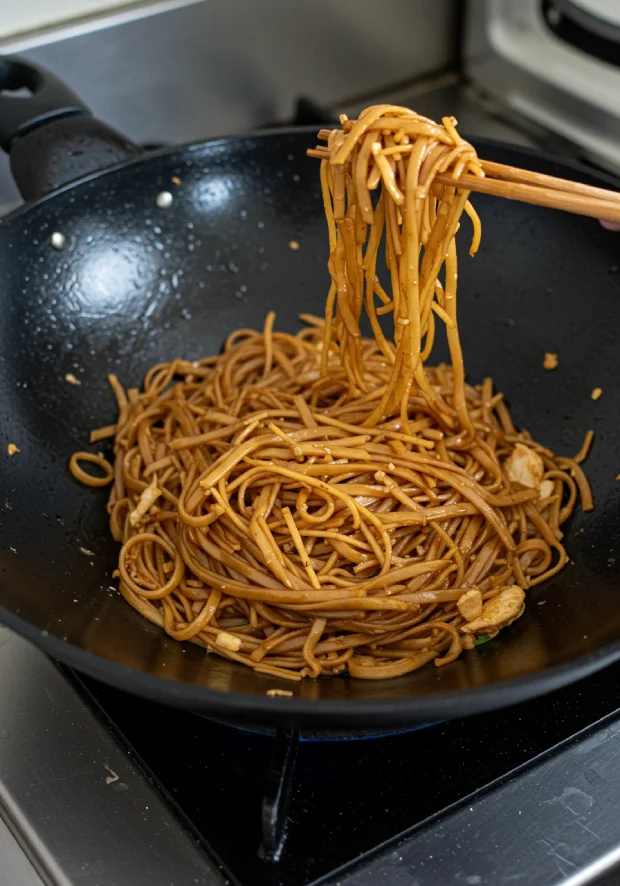

1. Blitz & Bloom the Chili Paste
Time: 3 minutes
Blend soaked dried chilies, fresh chilies, shallots, and garlic into a paste. Heat 1 tsp oil in your wok, then sizzle the paste until it smells like a Malaysian night market (about 2 minutes). Freeze extras in ice cube trays for future stir-fries!
2. Wok Warfare: Stir-Fry Like a Boss
Time: 7 minutes
- Heat the wok until it’s smoking. No shy flames here—high heat = authentic char.
- Add 2 tbsp oil, then garlic. Stir for 10 seconds until golden.
- Toss in prawns and Chinese sausage. Cook for 1 minute until prawns blush pink.
- Add noodles and sauce. Toss aggressively—use tongs to coat every strand.
- Crack an egg over the noodles. Let it set slightly, then scramble it into the mix for creamy richness.
3. Finish with Finesse
Time: 2 minutes
Fold in bean sprouts, chives, and cockles. Serve immediately with lime wedges and extra chili paste for daredevils.
Troubleshooting:
- Noodles sticking? Add 1 tbsp water or broth to loosen.
- Too salty? Balance with a squeeze of lime or ½ tsp sugar.
Customize Your Kway Teow
Vegan Delight
- Swap prawns for crispy tofu (air-fry 15 mins ahead).
- Use mushroom broth instead of fish sauce.
- Skip the egg; add cubed avocado for creaminess.
Arsonist-Level Spice
- Double the chili paste.
- Add 1 sliced bird’s eye chili.
- Finish with chili crisp oil.
Kid-Friendly Twist
- Omit fresh chilies; use ½ tsp sweet paprika.
- Add shredded carrots and snap peas for crunch.
- Serve with peanut sauce for dipping.
Nutrition Facts (Approximate)
Per serving:
- Calories: 450
- Protein: 22g (great for post-gym recovery!)
- Carbs: 65g (noodles = comfort fuel)
- Fat: 12g
Note: Values vary with substitutions. For exact counts, use apps like MyFitnessPal.
Storing & Reheating Like a Pro
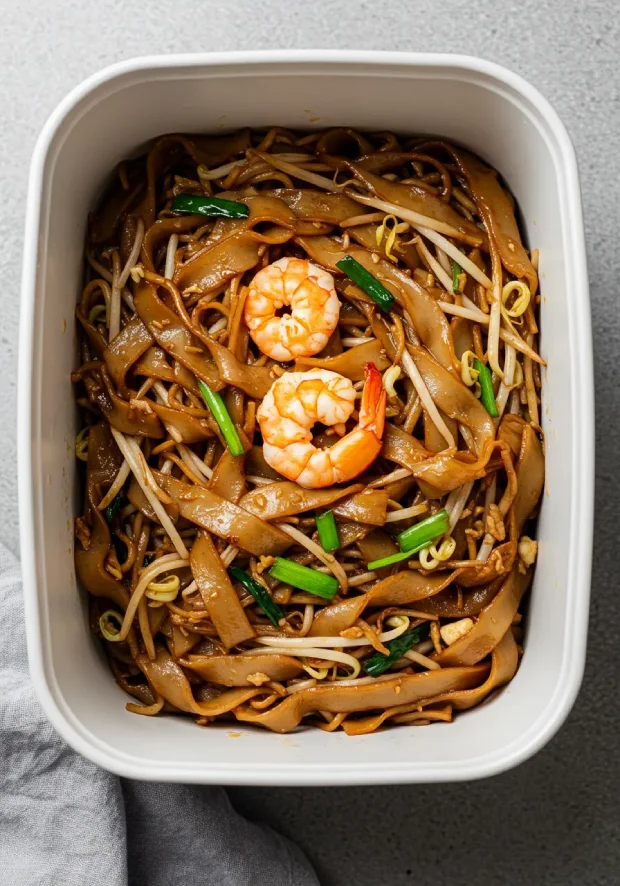

Fridge:
- Store in airtight containers for up to 3 days.
- Pro Tip: Keep noodles and veggies separate to prevent sogginess.
Reheat:
- Pan Method: Heat 1 tsp oil, stir-fry leftovers 3-4 minutes. Splash with water if dry.
- Microwave: Cover with a damp paper towel; nuke for 1 minute, stir, and repeat.
Freezer:
- Not ideal—noodles turn mushy. If you must, freeze sauce separately.
FAQs: Your Kway Teow Cheat Sheet
Q: Can I use dried rice noodles?
A: Absolutely! Soak in warm water for 10 minutes until flexible. Drain well and toss with oil to prevent sticking.
Q: My sauce tastes flat. Help!
A: Brighten it up! Add 1 tsp lime juice or ½ tsp rice vinegar.
Q: Where do I find Chinese sausage?
A: Asian grocery stores or online (try Amazon). Substitute with smoked turkey sausage.
Q: Can I meal prep this?
A: Prep chili paste and chop veggies ahead. Cook noodles fresh for the best texture.
Q: Is Kway Teow gluten-free?
A: Yes! Use tamari instead of soy sauce, and ensure fish sauce is GF (Red Boat is a safe brand).
Explore More Takeout Fakeouts!
Loved this recipe? Level up your stir-fry game:
- 15-Minute Pad Thai: Peanutty perfection.
- Garlic Noodles: 5 ingredients, insane flavor.
- Veggie Lo Mein: Clean-out-the-fridge genius.
Rate This Recipe ⭐⭐⭐⭐⭐
Tried it? Tag @kitchenslovers on Instagram with #KwayTeowMagic—we might feature your dish!
About Nadia Else
Nadia Else is a culinary expert and food photographer who turns “meh” meals into “MORE, PLEASE!” Known for sharing easy, family-friendly meals and decadent desserts, she transforms simple ingredients into unforgettable dishes. As a seasoned recipe developer, Nadia brings approachable creativity and mouthwatering visuals to every recipe, inspiring home cooks to fall in love with cooking.
Love This Recipe?
Dive into more indulgent recipes in our Dinner Category
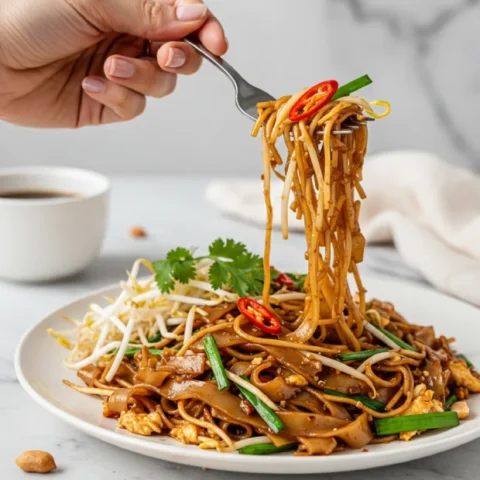

Kway Teow
A 22-minute stir-fry bursting with smoky "wok hei" flavor! Chewy rice noodles, plump prawns, and a sweet-spicy sauce come together for an authentic Malaysian street food experience at home.
Ingredients
- Chili Paste (the flavor engine):
- 1 oz dried red chilies (soaked) → Too spicy? Use 1 tbsp smoked paprika + 1 tsp cayenne.
- 2 fresh red chilies → Swap with bell peppers for zero heat.
- 3 shallots → Red onion works in a pinch.
- The Sauce (where magic happens):
- 5 tbsp soy sauce → Tamari for gluten-free.
- 1.5 tbsp dark soy sauce → Coconut aminos add sweetness.
- 1 tbsp sugar → Honey or maple syrup for unrefined options.
- ½ tsp fish sauce → Mushroom broth for vegan umami.
- Stir-Fry Stars:
- 1 lb fresh flat rice noodles → Look for “pad see ew” noodles.
- 12 prawns → Chicken thighs, tofu, or extra mushrooms.
- Blood cockles → Clams, mussels, or omit for budget-friendly.
- Chinese sausage → chorizo or smoked tempeh.
Instructions
- Blitz & Bloom the Chili Paste: Blend soaked dried chilies, fresh chilies, shallots, and garlic into a paste. Heat 1 tsp oil in your wok, then sizzle the paste until it smells like a Malaysian night market (about 2 minutes). Freeze extras in ice cube trays for future stir-fries!
- Wok Warfare: Stir-Fry Like a Boss: Heat the wok until it’s smoking. No shy flames here—high heat = authentic char.
Add 2 tbsp oil, then garlic. Stir for 10 seconds until golden.
Toss in prawns and Chinese sausage. Cook for 1 minute until prawns blush pink.
Add noodles and sauce. Toss aggressively—use tongs to coat every strand.
Crack an egg over the noodles. Let it set slightly, then scramble it into the mix for creamy richness. - Finish with Finesse: Fold in bean sprouts, chives, and cockles. Serve immediately with lime wedges and extra chili paste for daredevils.
Notes
Nutrition Information:
Yield: 4 Serving Size: 4Amount Per Serving: Calories: 450Total Fat: 12gSaturated Fat: 3gTrans Fat: 0gUnsaturated Fat: 9gCholesterol: 130mgSodium: 1000mgCarbohydrates: 58gNet Carbohydrates: 60gFiber: 3gSugar: 9gSugar Alcohols: 0gProtein: 20g


